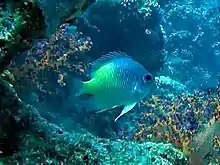Amblyglyphidodon flavilatus
Amblyglyphidodon flavilatus, known as yellow damselfish, yellowfin damselfish, yellow flank damselfish, yellow side damselfish, and yellow-sided Damselfish,[2] is part Pomacentridae, which is a family of ray-finned fish including damselfish and clownfish. This family represents the greatest diversity and abundance of fish species inhabiting coral reefs.[3] They were first discovered in the 1980s by Allen and Randall.[4]
| Amblyglyphidodon flavilatus | |
|---|---|
 | |
| Scientific classification | |
| Kingdom: | Animalia |
| Phylum: | Chordata |
| Class: | Actinopterygii |
| Family: | Pomacentridae |
| Genus: | Amblyglyphidodon |
| Species: | A. flavilatus |
| Binomial name | |
| Amblyglyphidodon flavilatus Allen & Randall, 1980 | |
Habitat
Amblyglyphidodon flavilatus is a reef dwelling fish, most often found at coastal fringing reefs and reef slopes. It is only found between the depths of twelve and twenty meters. The Amblyglyphidodon flavilatus has not been known to migrate from their spots, so they are non-migratory fish.[5] They prefer warmer water, between temperatures from 72-78 °F. The Amblyglyphidodon flavilatus This species is native to the western Indian Ocean, from the Red Sea and the Gulf of Aden.,[1][6] specifically in Djibouti, Egypt, Eritrea, Israel, Jordan, Saudi Arabia, Somalia, Sudan, and Yemen.[7]
Description
Amblyglyphidodon flavilatus has a total of thirteen dorsal spines, these would be spines on the top or back of the fish. It also has eleven to thirteen dorsal soft rays, which are segmented fin rays that are composed of two closely joined lateral elements. The dorsal soft rays are almost always flexible and often branched. The Amblyglyphidodon flavilatus has two anal spines, and eleven to thirteen anal soft rays. The overall color is pearly white; with the anterior half being grayish, the chest is predominately pearly white, and the posterior half of body is a yellowish color.[5] (hence the Latin species name flavilatus, meaning with yellow sides) and a pearly white chest.[5]
Many pomacentrid species are intensely territorial and compete for space both within and among species.[8] The territory they defend are called "agal gardens" which are large patches of algae that they cultivate and take care of.[3] The reproductive patterns of some damselfish are related to periodic rainfall and wind changes in tropical areas.[9][10] some authors suggest that the synchrony of the reproductive activities of damselfishes is influenced by the lunar cycle.[11][12]
Biology
Amblyglyphidodon flavilatus are Oviparous, which means that they produce young by means of eggs that are hatched after they have been laid by the parent.[13] There is very little embryonic development involved in oviparous eggs. The Amblyglyphidodon flavilatus shows distinct pairing during breeding. Eggs are demersal (living close to the floor of the sea or a lake)[14] and adhere to the substrate. Male damselfish guard and aerate the eggs. These fishes mainly feed on zooplankton.[2] The Amblyglyphidodon flavilatus are currently registered as “least concerned” and have a stable population.[15]
References
- Allen, G.; Williams, J.T. & Larson, H. (2017). "Amblyglyphidodon flavilatus". IUCN Red List of Threatened Species. 2017: e.T188560A1893062. doi:10.2305/IUCN.UK.2017-2.RLTS.T188560A1893062.en.
- "The Yellow-sided Damselfish - Whats That Fish!". www.whatsthatfish.com. Retrieved 2019-04-03.
- Choi, Young-Ung (2013). "Annual reproductive cycle of female staghorn damselfish Amblyglyphidodon curacao in the Chuuk Lagoon, Micronesia". Ichthyological Research. 60 (2): 198–201. doi:10.1007/s10228-012-0322-y.
- "WoRMS - World Register of Marine Species - Amblyglyphidodon flavilatus Allen & Randall, 1980". www.marinespecies.org. Retrieved 2019-04-03.
- "Amblyglyphidodon flavilatus summary page". FishBase. Retrieved 2019-04-03.
- Froese, Rainer and Pauly, Daniel, eds. (2018). "Amblyglyphidodon flavilatus" in FishBase. June 2018 version.
- "WoRMS - World Register of Marine Species - Pomacentrus aquilus Allen & Randall, 1980". www.marinespecies.org. Retrieved 2019-04-03.
- Allen, G.R (1991). Damselfishes of the world. Germany: Mergus Publishers. ISBN 3882440082.
- Stanton FG, Tyler WA. "Potential influence of food abundance onspawning patterns in a damselfish, Abudefduf abdominalis". Bull. Mar. Sci.
- Srinivasan M, Jones GP (2006). "Extended breeding and recruitment periods of fishes on a low latitude coral reef". Coral Reefs. 25.
- Pressley, PH (1980). "Lunar periodicity in the spawning of yellowtail damselfish, Microspathodon chrysurus". Env Biol Fish.
- Foster, S.A. (1987). "Diel and lunar patterns of reproduction in the Caribbean and Pacific sergeant major damselfishes Abudefduf saxatilis and A. troschelii". Marine Biology. doi:10.1007/bf00409563.
- "the definition of oviparous". www.dictionary.com. Retrieved 2019-04-03.
- "demersal | Definition of demersal in English by Oxford Dictionaries". Oxford Dictionaries | English. Retrieved 2019-04-03.
- "The IUCN Red List of Threatened Species". IUCN Red List of Threatened Species. Retrieved 2019-04-03.
External links
- Inaturalist
- Photos of Amblyglyphidodon flavilatus on Sealife Collection
